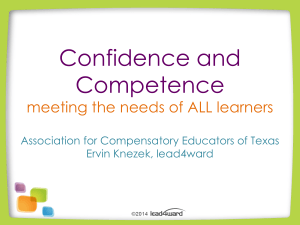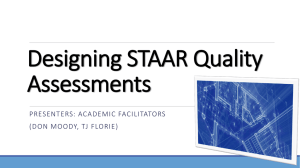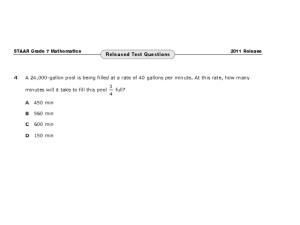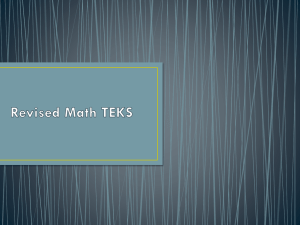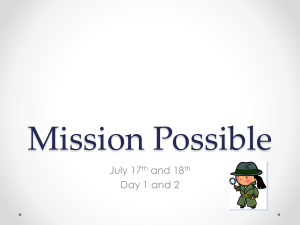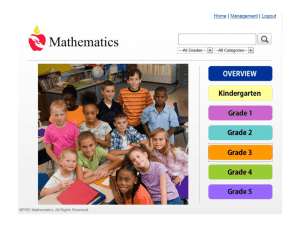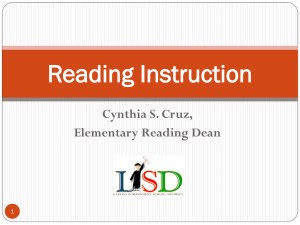Best Way to Prepare for STAAR and Eliminate Stress….
advertisement
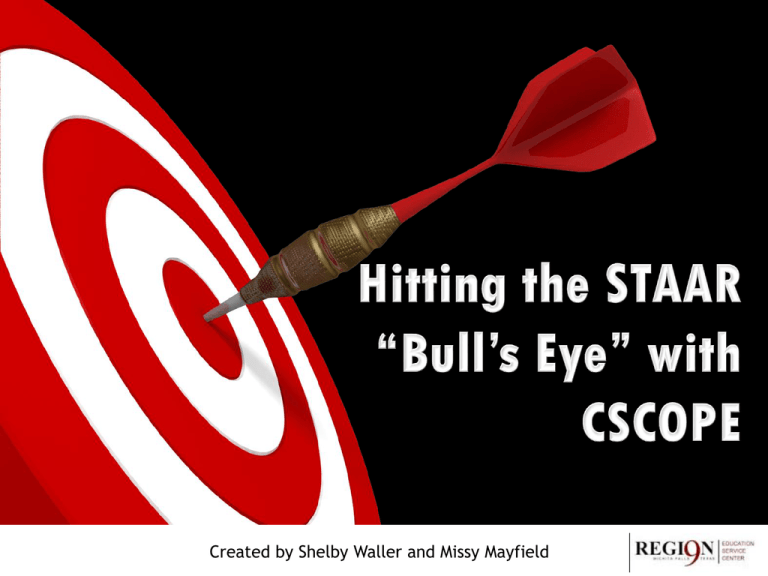
Created by Shelby Waller and Missy Mayfield ON TARGET • Professionalism: Refrain from using electronic devices until appropriate, please. • Participate actively. • What is said here stays here, but what you learn here leaves here. ON TARGET CSCOPE & STAAR ON TARGET Teachers’ Perspective ON TARGET Best Way to Prepare for STAAR and Eliminate Stress…. Know your TEKS… • Inside-out • Upside-down • Backwards & forwards! We must get our heads “out of the sand” and be honest with how well we truly understand our TEKS. ON TARGET Picture this…. • Mrs. Sims is a teacher who: • Has GREAT relationships with students! • Uses Research-based strategies! • Engages students actively! • Teaches students to identify cell organelles because she knows these concepts are in her TEKS! However,COGNITIVE she did not closely examine the RIGOR actual TEKS: 7.12(D) differentiate between structure and function in plant and animal cellCONTENT organelles, including cell membrane, cell wall, nucleus, CONTENT cytoplasm, mitochondrion, chloroplast, and vacuole; CONTENT ON TARGET Mrs. Sims failed to help students DIFFERENTIATE between STRUCTURE and FUNCTION … and she did not include anything about plant cells. ON TARGET How do you think her students will perform on the STAAR? ON TARGET The BEST teachers will be considered “inadequate” if they do not UNDERSTAND and TEACH TO the cognitive and content rigor of their standards as they prepare students for STAAR! ON TARGET A New View of Assessment “More Focus, More Clarity, More Depth” ON TARGET More Focus: “Readiness” and “Supporting” TEKS standards are identified. More Clarity: TEA will communicate these differing skills and will communicate the connection between the TEKS and the STAAR. More Depth: Inclusion of items measuring higher cognitive complexity to prepare for the next grade and ultimately, college. ON TARGET How does TAKS compare to STAAR? Information adapted from TEA article A Comparison of Assessment Attributes TAKS to STAAR™ http://www.tea.state.tx.us/student.assessment/staar/ Rigor of Assessment Performance Standards were approved in 2001 Perf. Standards have remained the same: therefore, students have “outgrown” the test Item development process followed since guidelines developed in 2001 TAKS Commended Perf. difficult to measure because there are too few rigorous items Science & Math = few open-ended items Tests will increase in length at most grades Both have Performance Standards or Measures 4th & 7th Writing = 1 writing task Thinking Maps Double Bubble Map® Test difficulty will increase by adding more rigorous items at a greater depth of cognitive complexity STAAR EOC Science & Math = more open-ended items (not multiple choice… derive answer on your own) Why more Rigor? • Better able to measure growth of high-achieving students • Better alignment to the VERBS in the TEKS SEs Perf. Measures will be set using empirical data that links perf. year to year 4th & 7th Writing = 2 writing tasks instead of 1 Perf. Standards will be reviewed every 3 years & adjusted if appropriate to maintain a high standard of rigor Empirical Data = Compare student perf. with nationally normedreferenced tests Possible Writing Tasks: • Personal narrative • Literary • Expository • Persuasive • Analytic ON TARGET Other Indications of STAAR’s Rigor • Bundling of Standards allows skills to be tested in more integrated and authentic ways • Assessments will focus on mastery of SE’s essential for the current grade or course, and building blocks for subsequent grades ON TARGET Assessments will be back-mapped from the capstone courses. Assessed Curriculum SE’s grouped by Objectives 5th , 8th Science and 9 – 11 Tests assessed content from multiple courses Tested SEs determined by Tx. Teachers Tested SEs determined by educator committees Blueprints Developed TAKS 30 – 60 items on each test: 1 essay in 4th & 7th 3rd – grade test grade level content only Blueprints focused on # of items per objective Thinking Maps Double Bubble Map® 8th (except 5th & 8th science) SEs grouped by: • Readiness • Supporting • Cannot be assessed STAAR EOC Blueprints will focus on standards that prepare students for the next grade/course Readiness SEs: • Tested every yr • Essential for success in current gr. • Important for next grade • Supports CCRS • Requires in-depth instruction • Broad/deep ideas 9th – 12th EOCs will test ONLY grade level content Tests will be longer: 2 essays in 4th & 7th 5th Sci – will include some 3rd/4th 8th Sci – will include some 6th/7th Supporting SEs: • Tested on a rotation • Introduced in current gd. Or… • Reinforced in current gd. • Emphasized in another gd. • Do not play a central role for next gd. • Narrow ideas Readiness (Core) Knowledge and Skills: Will be stable, static TEKS assessed annually Supporting (Rotational) Knowledge and Skills: TEKS that will be assessed on a three-year rotational basis. Example: An initial committee review found about 1/3 of reading TEKS to be considered “core”. These Core TEKS could make up 50-60% of the test ON TARGET ON TARGET How will CSCOPE address the new STAAR requirements? STAAR assessments will be closely aligned to the TEKS, and the TEKS are the cornerstone of every CSCOPE component. Therefore, if teachers utilize CSCOPE as a systemic approach to teaching and learning, they will be preparing students for STAAR and EOC. The table below reflects how CSCOPE is currently in line with STAAR elements: TEKS Student Expectations will be bundled in a way that students may encounter several skills assessed within one test question. CSCOPE Unit Assessments bundle Student Expectations for each unit of study. CSCOPE IFDs bundle Student Expectations into units of study. Test questions will align to the content AND cognitive rigor of the TEKS. CSCOPE Unit Assessment questions are aligned to the CONTENT and COGNITIVE RIGOR of the TEKS. CSCOPE IFDs bundle Student Expectations into specific units of study, focusing on the CONTENT and COGNITIVE RIGOR of the standards. CSCOPE IFDs and VADs highlight the COGNITIVE RIGOR of each Student Expectation (the verbs) to ensure teachers are informed of the depth to which they should be teaching and that will be assessed on STAAR. CSCOPE IFDs and VADs highlight the CONTENT specificity of each standard by providing detailed ways teachers can target (“hit the bulls eye”) their instruction of each Student Expectation. CSCOPE Exemplar Lessons are aligned to the IFDs that bundle TEKS and provide strategies that promote student exposure to the CONTENT and COGNITIVE RIGOR of each Student Expectation. ON TARGET • Rest assured that CSCOPE currently assists teachers in understanding their TEKS and the content and cognitive rigor of each standard better than they have ever understood it before! • This depth of understanding will in turn help teachers prepare students for STAAR and EOC. ON TARGET However, because CSCOPE is a responsive curriculum system created BY Texas teachers FOR Texas teachers, CSCOPE wants to take things a step further to assist educators and students as we approach this new assessment system. ON TARGET State CSCOPE staff have already begun an initial review of the curriculum components in all content areas with regard to STAAR requirements, including the Readiness and Supporting standard designations. The table below reflects State CSCOPE’s overall revision process for each CSCOPE component based on STAAR requirements. YAGs YAGs will be audited and revised (as necessary) to ensure all newly identified “Readiness” and “Supporting” TEKS are bundled into units BEFORE the STAAR assessments occur. TEKS will be labeled “Readiness” or “Supporting” on the TEKS Verification Matrix as applicable. TEKS Verification Matrix TEKS will be identified as “Readiness” or “Supporting” on the VAD. VADs IFDs will be audited and revised (as necessary) to ensure TEKS are bundled appropriately. A Performance Indicator review will be necessary at all grade IFDs levels to ensure that the readiness and supporting standards are the primary focus of the performance assessment in the unit. Unit Assessments Unit tests will continue to bundle Student Expectations and mirror the content and cognitive rigor of the TEKS. Exemplar Lessons Exemplar lessons will continue to align to the IFDs and will continue to promote the CONTENT and COGNITIVE rigor of the standards, as well as highlighting “Readiness” and “Supporting” standards. To this!

